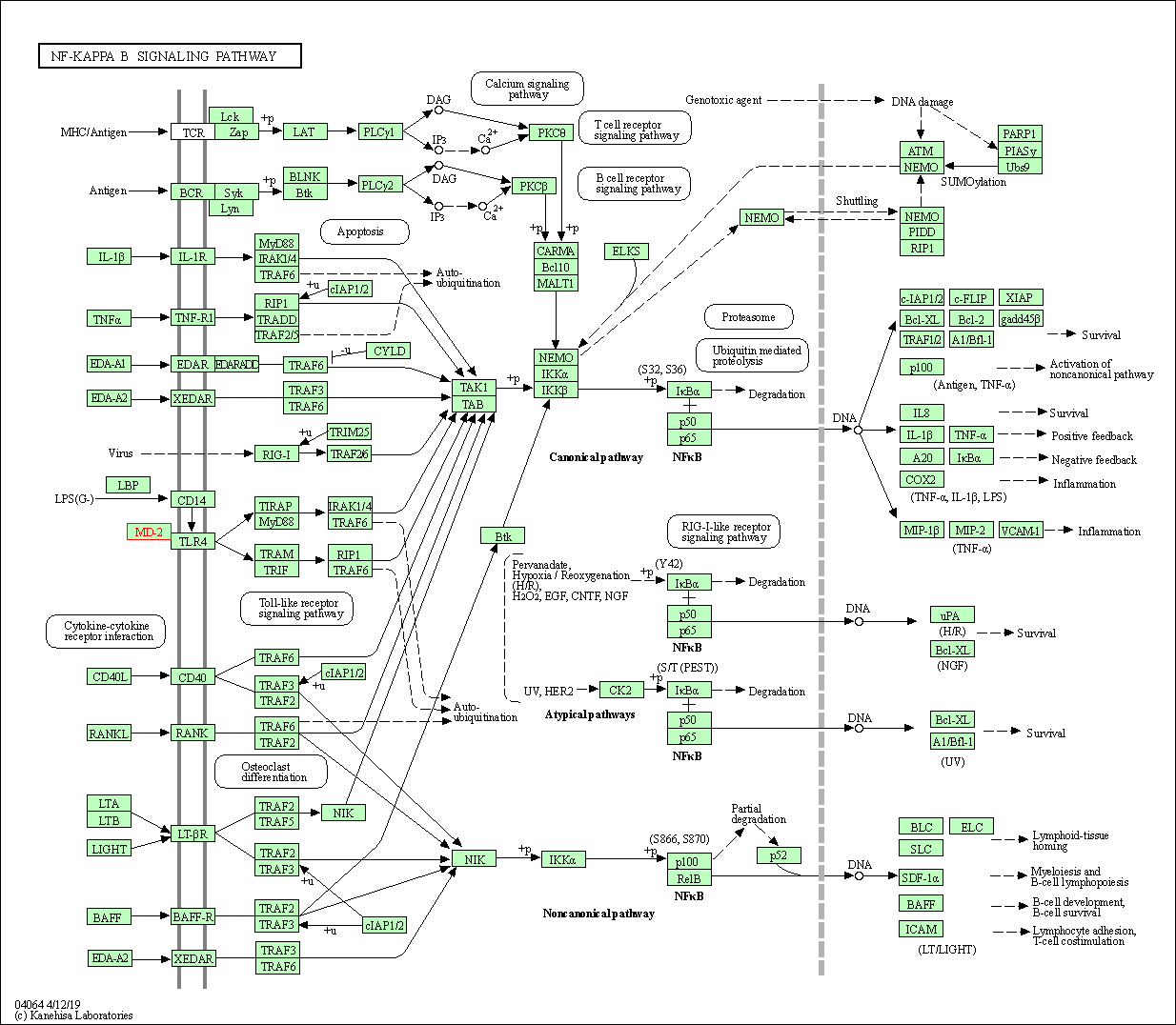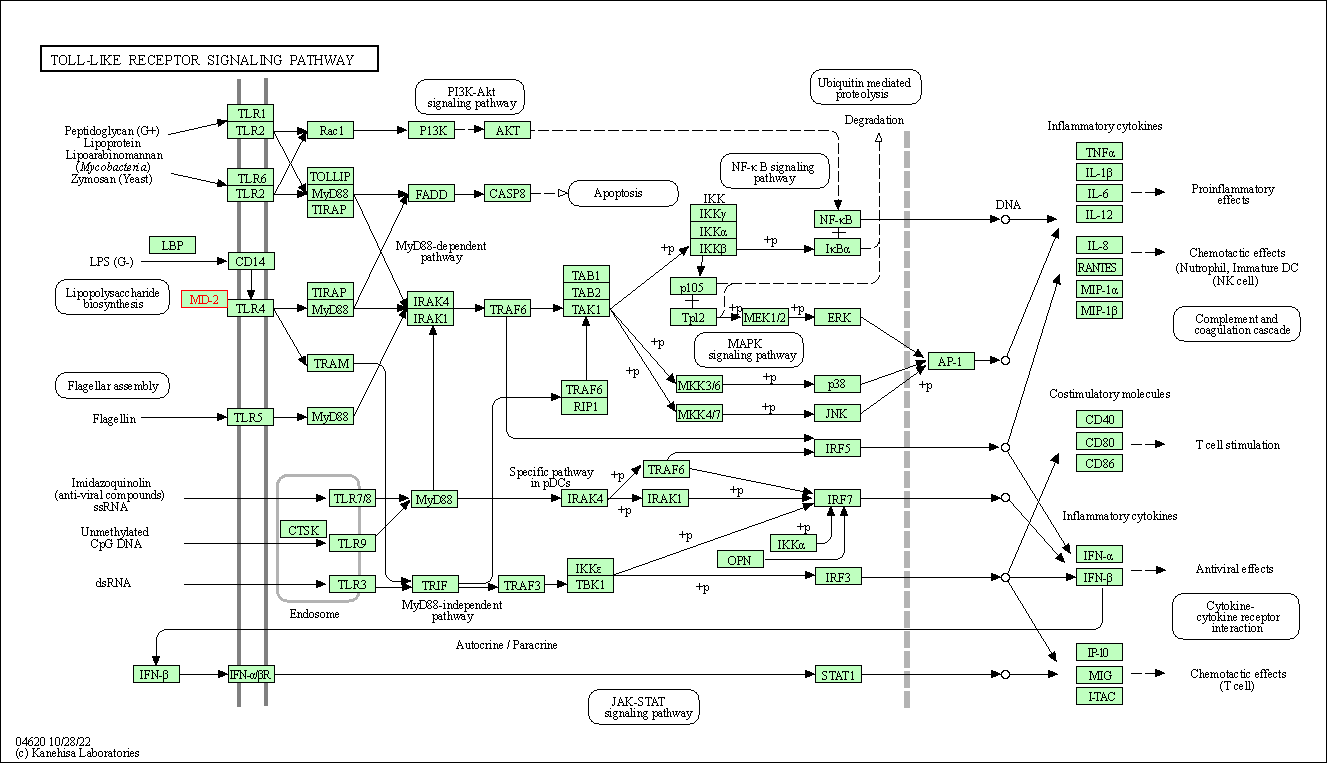Target Information
| Target General Information | Top | |||||
|---|---|---|---|---|---|---|
| Target ID |
T52382
(Former ID: TTDR00927)
|
|||||
| Target Name |
Lymphocyte antigen 96 (LY96)
|
|||||
| Synonyms |
MD-2 protein; MD-2; LY96; ESOP-1
Click to Show/Hide
|
|||||
| Gene Name |
LY96
|
|||||
| Target Type |
Literature-reported target
|
[1] | ||||
| Function |
Cooperates with TLR4 in the innate immune response to bacterial lipopolysaccharide (LPS), and with TLR2 in the response to cell wall components from Gram-positive and Gram-negative bacteria. Enhances TLR4-dependent activation of NF-kappa-B. Cells expressing both MD2 and TLR4, but not TLR4 alone, respond to LPS.
Click to Show/Hide
|
|||||
| UniProt ID | ||||||
| Sequence |
MLPFLFFSTLFSSIFTEAQKQYWVCNSSDASISYTYCDKMQYPISINVNPCIELKRSKGL
LHIFYIPRRDLKQLYFNLYITVNTMNLPKRKEVICRGSDDDYSFCRALKGETVNTTISFS FKGIKFSKGKYKCVVEAISGSPEEMLFCLEFVILHQPNSN Click to Show/Hide
|
|||||
| 3D Structure | Click to Show 3D Structure of This Target | PDB | ||||
| HIT2.0 ID | T15ZAV | |||||
| Cell-based Target Expression Variations | Top | |||||
|---|---|---|---|---|---|---|
| Cell-based Target Expression Variations | ||||||
| Drug Binding Sites of Target | Top | |||||
|---|---|---|---|---|---|---|
| Ligand Name: ERITORAN | Ligand Info | |||||
| Structure Description | Crystal structure of the human TLR4 TV3 hybrid-MD-2-Eritoran complex | PDB:2Z65 | ||||
| Method | X-ray diffraction | Resolution | 2.70 Å | Mutation | No | [3] |
| PDB Sequence |
QKQYWVCNSS
28 DASISYTYCD38 KMQYPISINV48 NPCIELKGSK58 GLLHIFYIPR68 RDLKQLYFNL 78 YITVNTMNLP88 KRKEVICRGS98 DDDYSFCRAL108 KGETVNTTIS118 FSFKGIKFSK 128 GKYKCVVEAI138 SGSPEEMLFC148 LEFVILHQPN158
|
|||||
|
|
ILE32
4.452
ILE46
3.506
VAL48
4.481
ILE52
4.217
LEU54
4.852
LEU61
3.964
ILE63
3.727
TYR65
3.497
LEU71
4.181
LEU74
4.596
PHE76
3.934
LEU78
4.528
ILE80
4.211
LEU87
3.649
ILE94
4.934
TYR102
3.372
PHE104
3.522
|
|||||
| Ligand Name: Myristic acid | Ligand Info | |||||
| Structure Description | Crystal structure of human MD-2 | PDB:2E56 | ||||
| Method | X-ray diffraction | Resolution | 2.00 Å | Mutation | No | [4] |
| PDB Sequence |
EAQKQYWVCN
26 SSDASISYTY36 CDKMQYPISI46 NVNPCIELKG56 SKGLLHIFYI66 PRRDLKQLYF 76 NLYITVNTMN86 LPKRKEVICR96 GSDDDYSFCR106 ALKGETVNTT116 ISFSFKGIKF 126 SKGKYKCVVE136 AISGSPEEML146 FCLEFVILHQ156 PNSN
|
|||||
|
|
ILE32
4.276
ILE44
4.638
ILE46
4.340
VAL48
3.569
ILE52
3.151
LEU61
3.752
ILE63
4.142
TYR65
4.270
LEU71
4.406
LEU74
4.064
PHE76
4.051
LEU78
4.272
GLU92
3.930
VAL93
4.556
ILE94
4.019
|
|||||
| Click to View More Binding Site Information of This Target and Ligand Pair | ||||||
| Click to View More Binding Site Information of This Target with Different Ligands | ||||||
| Different Human System Profiles of Target | Top |
|---|---|
|
Human Similarity Proteins
of target is determined by comparing the sequence similarity of all human proteins with the target based on BLAST. The similarity proteins for a target are defined as the proteins with E-value < 0.005 and outside the protein families of the target.
A target that has fewer human similarity proteins outside its family is commonly regarded to possess a greater capacity to avoid undesired interactions and thus increase the possibility of finding successful drugs
(Brief Bioinform, 21: 649-662, 2020).
Human Pathway Affiliation
of target is determined by the life-essential pathways provided on KEGG database. The target-affiliated pathways were defined based on the following two criteria (a) the pathways of the studied target should be life-essential for both healthy individuals and patients, and (b) the studied target should occupy an upstream position in the pathways and therefore had the ability to regulate biological function.
Targets involved in a fewer pathways have greater likelihood to be successfully developed, while those associated with more human pathways increase the chance of undesirable interferences with other human processes
(Pharmacol Rev, 58: 259-279, 2006).
Biological Network Descriptors
of target is determined based on a human protein-protein interactions (PPI) network consisting of 9,309 proteins and 52,713 PPIs, which were with a high confidence score of ≥ 0.95 collected from STRING database.
The network properties of targets based on protein-protein interactions (PPIs) have been widely adopted for the assessment of target’s druggability. Proteins with high node degree tend to have a high impact on network function through multiple interactions, while proteins with high betweenness centrality are regarded to be central for communication in interaction networks and regulate the flow of signaling information
(Front Pharmacol, 9, 1245, 2018;
Curr Opin Struct Biol. 44:134-142, 2017).
Human Similarity Proteins
Human Pathway Affiliation
Biological Network Descriptors
|
|
| Protein Name | Pfam ID | Percentage of Identity (%) | E value |
|---|---|---|---|
| Lymphocyte antigen 96 (LY96) | 100.000 (160/160) | 6.55E-119 | |
| Lymphocyte antigen 86 (LY86) | 24.818 (34/137) | 2.32E-05 | |


| KEGG Pathway | Pathway ID | Affiliated Target | Pathway Map |
|---|---|---|---|
| NF-kappa B signaling pathway | hsa04064 | Affiliated Target |

|
| Class: Environmental Information Processing => Signal transduction | Pathway Hierarchy | ||
| Toll-like receptor signaling pathway | hsa04620 | Affiliated Target |

|
| Class: Organismal Systems => Immune system | Pathway Hierarchy | ||
| Degree | 16 | Degree centrality | 1.72E-03 | Betweenness centrality | 3.09E-04 |
|---|---|---|---|---|---|
| Closeness centrality | 2.27E-01 | Radiality | 1.40E+01 | Clustering coefficient | 3.50E-01 |
| Neighborhood connectivity | 2.43E+01 | Topological coefficient | 1.19E-01 | Eccentricity | 12 |
| Download | Click to Download the Full PPI Network of This Target | ||||
| Chemical Structure based Activity Landscape of Target | Top |
|---|---|
| Drug Property Profile of Target | Top | |
|---|---|---|
| (1) Molecular Weight (mw) based Drug Clustering | (2) Octanol/Water Partition Coefficient (xlogp) based Drug Clustering | |
|
|
||
| (3) Hydrogen Bond Donor Count (hbonddonor) based Drug Clustering | (4) Hydrogen Bond Acceptor Count (hbondacc) based Drug Clustering | |
|
|
||
| (5) Rotatable Bond Count (rotbonds) based Drug Clustering | (6) Topological Polar Surface Area (polararea) based Drug Clustering | |
|
|
||
| "RO5" indicates the cutoff set by lipinski's rule of five; "D123AB" colored in GREEN denotes the no violation of any cutoff in lipinski's rule of five; "D123AB" colored in PURPLE refers to the violation of only one cutoff in lipinski's rule of five; "D123AB" colored in BLACK represents the violation of more than one cutoffs in lipinski's rule of five | ||
| References | Top | |||||
|---|---|---|---|---|---|---|
| REF 1 | How many drug targets are there Nat Rev Drug Discov. 2006 Dec;5(12):993-6. | |||||
| REF 2 | The Protein Data Bank. Nucleic Acids Res. 2000 Jan 1;28(1):235-42. | |||||
| REF 3 | Crystal structure of the TLR4-MD-2 complex with bound endotoxin antagonist Eritoran. Cell. 2007 Sep 7;130(5):906-17. | |||||
| REF 4 | Crystal structures of human MD-2 and its complex with antiendotoxic lipid IVa. Science. 2007 Jun 15;316(5831):1632-4. | |||||
If You Find Any Error in Data or Bug in Web Service, Please Kindly Report It to Dr. Zhou and Dr. Zhang.

